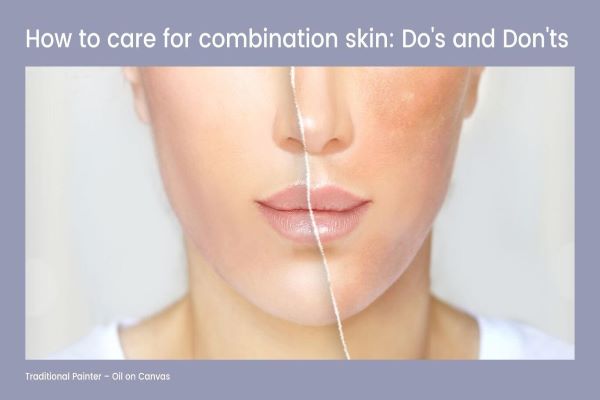Combination skin can be a real pain to deal with. One day your skin is oily and the next it’s dry. So what’s a person to do? How can you establish the best skin care routine for combination skin?
One of the most important things to remember when it comes to combination skin is that you can’t just focus on one area. You need to treat your entire face equally.
That means researching and using skincare products designed for combination skin, knowing when to use different products for different areas of your combination skin, establishing a proper routine that works, and sticking with it. In this article, you’ll also learn about the do’s and don’ts of taking care of combination skin.
What is combination skin and why is it difficult to take care of?

Combination skin is a skin type that is oily in some areas and dry in others. It can be difficult to take care of because you have to deal with two different types of skin at the same time. Oily skin can be a breeding ground for bacteria and can lead to acne, while dry skin can be itchy and irritated.
Combination skin is caused by a variety of factors
Genetics
One of the main causes of combination skin is genetics. If your parents have combination skin, then you are more likely to have it too.
Hormonal changes
Hormonal changes can also cause your skin to change, so if you’re pregnant or going through menopause, your skin may become more combination.
Environmental factors
Environmental factors such as sun exposure, pollution, and wind can also contribute to combination skin.
The do’s of taking care of combination skin
oily areas:
– Use a gel-based, non-irritating, non-foaming gentle cleanser to wash your face. Washing your face too often can aggravate oily skin, so try to limit yourself to once or twice a day.
– Be guided by the dry areas. The goal is to apply a hydrating, non-greasy, non-occlusive product to your skin. sunscreen is a must, as is a good antioxidant serum
– Use oil blotting paper to blot away the excess oil on your face throughout the day.
– Exfoliate your skin once or twice a week to get rid of the dead skin cells that can clog pores and cause breakouts.
dry areas:
– Use a gel-based, non-irritating, non-foaming gentle cleanser to wash your face. Washing your face too often can strip away the natural oils that your skin needs, so try to limit yourself to once or twice a day. Face cleansing needs are usually the same for dry areas as with oily areas. However, you will require a careful selection of face wash products suitable for both areas.
– Use a moisturizer that is a hydrating, non-greasy, non-occlusive product for your skin such as hyaluronic acid.
– Exfoliate your skin once or twice a week to get rid of the dead skin cells that can clog pores and cause breakouts.
– Apply a hydrating mask to your face once or twice a week to help lock in moisture.
– Drink plenty of water throughout the day to keep your skin hydrated from the inside out.
The don’ts of taking care of combination skin
– Don’t use harsh scrubs or exfoliants. These can irritate your skin and make the dry areas worse.
– Don’t neglect your skin. Be sure to cleanse, moisturize, and protect your skin every day.
– Don’t forget to wear sunscreen. The sun can aggravate both oily and dry skin, so be sure to apply a broad-spectrum sunscreen with an SPF of 30 or higher every day.
– Don’t pick at your skin. This can lead to infection and scarring.
By following these simple do’s and don’ts, you can help to manage your combination skin and keep it looking its best.
How to find a routine that works for you
The best way to take care of combination skin is to find a routine that works for you and stick with it. Everyone’s skin is different, so what works for one person may not work for another. Talk to your dermatologist or a skincare professional to find out what products are best for your skin type.
Once you find a routine that works, it’s like magic so stick with it! Consistency is key when it comes to taking care of your skin.
Skincare routine for combination skin
This may include using different products for your oily and dry areas. You should also make sure to clean your face twice a day, moisturize, and use sunscreen. If you are having trouble finding a routine that works, talk to your dermatologist or a skincare professional.
Final thoughts on the best skin care routine for combination
There are a few things to keep in mind when trying to find the best skin care routine for combination skin. Firstly, oily areas need to be treated differently than dry areas. Secondly, what works for one person might not work for another, so it’s important to find a routine that suits your individual needs. Here are some final thoughts on the best skin care routine for combination skin:
Do:
– Make sure to use a gentle, hydrating cleanser that won’t strip the skin of its natural oils.
– Use oil-free products on your face, especially in the T-zone (forehead, nose, and chin).
– Exfoliate once or twice weekly to help remove dead skin cells and keep pores clear.
– Use a light, hydrating, non-occlusive moisturizer to hydrate dry areas without making oily areas worse.
– Make sure to protect your skin with a lightweight sunscreen with at least SPF 30.
Don’t:
– Don’t skip cleansing just because you have dry skin – this will only make things worse in the long run.
– Don’t overdo it with exfoliation, as this can irritate and damage combination skin.
– Don’t use harsh products that strip away natural oils – this will only cause your skin to produce more oil in compensation.
– Use a light moisturizer on oily areas, and a heavier moisturizer on dry areas.
You can watch this video on how to care for combination skin
Learn more about how to care for all skin types
Conclusion
Taking care of combination skin can be a challenge, but by following these simple do’s and don’ts, you can help to manage your skin type and keep it looking its best. Remember to find a routine that works for you and stick with it! Consistency is key when it comes to skincare. Lastly, if you’re struggling to find a routine that works, talk to your dermatologist or a skincare professional for help.
